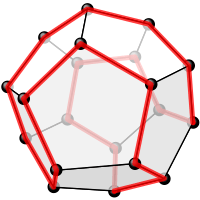Icosian game

One possible Hamiltonian cycle through every vertex of a dodecahedron is shown in red – like all platonic solids, the dodecahedron is Hamiltonian

The above as a two-dimensional planar graph
The icosian game is a mathematical game invented in 1857 by William Rowan Hamilton. The game's object is finding a Hamiltonian cycle along the edges of a dodecahedron such that every vertex is visited a single time, and the ending point is the same as the starting point. The puzzle was distributed commercially as a pegboard with holes at the nodes of the dodecahedral graph and was subsequently marketed in Europe in many forms.
The motivation for Hamilton was the problem of symmetries of an icosahedron, for which he invented icosians—an algebraic tool to compute the symmetries.[1] The solution of the puzzle is a cycle containing twenty (in ancient Greek icosa) edges (i.e. a Hamiltonian circuit on the dodecahedron).
See also
References
- ↑ "Icosian Game". Retrieved 2008-11-28.
External links
This article is issued from
Wikipedia.
The text is licensed under Creative Commons - Attribution - Sharealike.
Additional terms may apply for the media files.